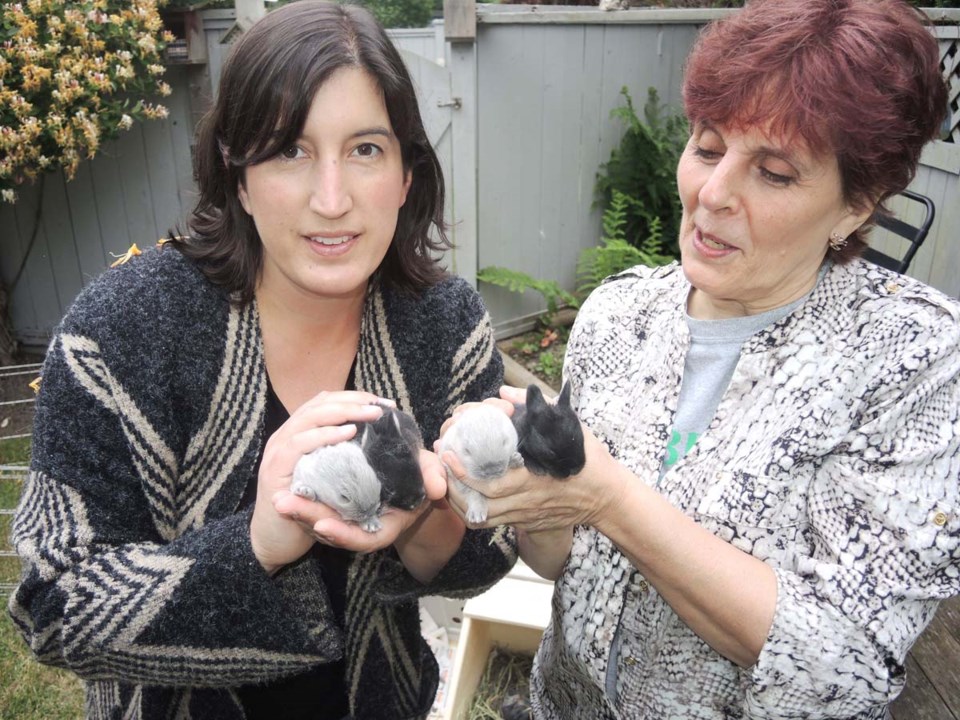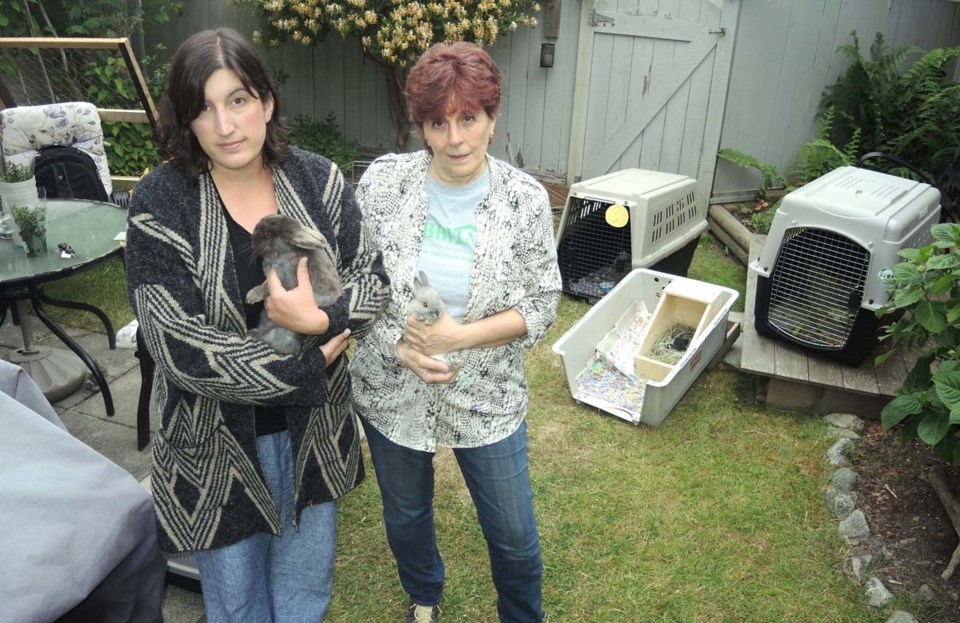Within four days, one had become seven and, by the end of the week, another three were taken into “custody” to prevent the proliferation getting out of control.
Amie Nowak isn’t even a “rabbit person,” and certainly doesn’t want to get into the “rabbit business.”
However, she also doesn’t want the bunnies multiplying by the dozen and wreaking havoc in her townhouse complex on the west dyke at the far end of Williams Road.
So, more than two weeks ago, when her daughter, Gabriella, came home with a lottery-winning smile and a rabbit in her arms, mom-of-two Nowak felt she had no choice but to adopt, at least for a few days.
Nowak, who already had two cats and a Guinea pig, stuck the rabbit into a cat carrier and started calling all the local animal shelters and rabbit rescues.
No one could take her, they’re all completely full, while the City of Richmond’s contracted animal shelter, RAPS, had to incinerate its rabbit accommodation after the March outbreak of rabbit hemorrhage disease (RHD).
She then managed to arrange for a mutual friend to permanently adopt the rabbit at the end of the week and offered to contribute towards getting her spayed.
But four days later, her eldest daughter came in and said the bunny had ripped off all of her belly fur and was making a nest.
“I was like ‘shut up, this is not happening.’ Two hours later, we now have six more little bunnies. The Internet told me it would be one to three days. It lied.
“The adoption was then off, obviously, because we can’t take the mom away from the babies.
“So then, we thought we might as well try to catch the rest out of the family out there before even more of them appear.”
Within a few more days, the Nowaks’ backyard had 10 rabbits in three crates, a pen and an eight-foot long wooden rabbit run, built by Nowak’s husband, Simon, who happens to be a secondary school woodwork teacher.
She’s now in the process of talking to her strata council to see if they can help with spaying and neutering the rabbits.
However, Nowak feels, if the city’s animal shelter and local rabbit rescues can’t help, the city itself has to step up.
“I don’t mind spaying or neutering one or two, but I’m not doing all of them,” she added. “We now have mom, dad and eight offspring, one went to Rabbitats and we think there are probably more roaming around out there, as well.
“We’d like to stay on top of this. It’s everyone’s problem and no one’s problem. It has now become our problem.
“But I really think the city needs to step up. Perhaps with some land to house them and maybe a spaying and neutering program.”
Nowak pointed out that rabbits, over time, do way more damage than cats and dogs — for which there is a spaying/neutering program — and rabbits “reproduce, like rabbits!”
Nowak’s ultimate plan is to find new homes for her makeshift “rabbit colony” via an Instagram account she has started up: Edgewater_Fluffle.
“But I can’t just give them out to anyone without them understanding what the rabbit needs, how long they live etc.,” she added.

One of the rabbit rescue charities, Rabbitats, has been advising Nowak on how to house and handle the rabbits and offering access to discounts on spaying and neutering.
Rabbitats’ founder, Sorelle Saidman, said the rabbit problem in Nowak’s townhouse complex is not isolated and is symptomatic of what’s happening across Richmond.
“It’s everywhere and we’re trying to get stratas on board across the city,” Saidman told theRichmond News.
“We had a community meeting at Cambie Community Centre two weeks ago. And it’s not the rabbit fans showing up, it’s the people living in stratas who are trying to save their landscaping. The problem has been getting worse over the last year.”
Saidman referenced a “10-year baby boom,” where, according to biologists, every decade, the rabbit population explodes.
In 2006, there was an explosion in Richmond and the city authorized a cull. But disease and starvation dealt with it before the cull was activated.
“That (natural cull) would have lasted a couple of years to 2008, so in 2018, here we are,” said Saidman, who has 225 rabbits at her South Surrey and Delta shelters and 20 or so in a trailer at Richmond Auto Mall.
Most of them, she said, came from the auto mall, which spent more than $60,000 a few years ago on a spaying and neutering program.
“We want the city to do the same on public property what stratas are willing to do on private property, otherwise it’s pointless,” explained Saidman.
“The auto mall is now faced with rabbits coming in again from city property. It’s nose to tail rabbits from the auto mall to Ikea, there are hundreds and hundreds. The control has to be city-wide.
“We need partnerships between the rescues and the city. The rescues, right now, are partnering with private property owners. But this is a big city and it has to be dealt with on city property as well.”
Saidman called for the city to release some land, set up a colony with a spaying/neutering and education program.
If nothing happens, she warns Richmond will undoubtedly have a bigger problem to deal with six months to a year down the line.
“This isn’t about saving the bunnies anymore, this is now about saving property,” she said.
“In six months’ time, property owners and the city will likely have spent thousands of dollars repairing the damage made by rabbits.
“A small investment now would likely save a lot of that expenditure.
“I’m not going to even lobby against a lethal cull, but the money that might be spent on that could easily go to a sanctuary with a spay and neuter program.”
RAPS, as the city’s contracted animal shelter, has been taking some heat from the rabbit rescue community for not doing more to help.
However, Pat Johnson, RAPS’ spokesperson, said the nature of the recent RHD outbreak meant the no-kill charity had to cull all of its 67 rabbits and incinerate everything related to them.
Johnson said it’s going to cost around $35,000 to rebuild the rabbit section; money which will have to be raised first.
RAPS estimates it will take until January to be in a position to accept rabbits again and, even then, it only has provision in its city contract for 24 rabbits.
“We don’t like to turn away any animals, we’re a no-kill shelter,” Johnson added.
“But we do have capacity limits for all of our animals.”
He said the reality is that an issue such as a rabbit population boom requires a “long-term commitment as it’s a significant problem.”
Asked if it should be doing more to deal with the situation, the City of Richmond said it was currently monitoring the situation with rabbits and has been in ongoing discussions with the Ministry of Forests, Lands and Natural Resource Operations and local animal charities.
“Unfortunately, the city is limited in what it can do in the area of rabbits as they are considered Schedule C Wildlife under provincial wildlife legislation,” said the city’s spokesperson, Ted Townsend, in a statement.
“The city can trap, hold, and euthanize rabbits, but not release or make available for adoption. The approach the city has taken is that of educating the public on the release of rabbits into parks and the feeding of rabbits, which are prohibited under civic bylaws.”
The city banned the sale of rabbits from stores in 2010 in a bid to deal with the recurring issue.
“We encourage other municipalities that have yet to ban sales of rabbits from pet stores to follow suit,” added Townsend.
“Many of the current feral rabbits in Richmond or their ancestors may have been purchased elsewhere but then released in Richmond.”
Townsend said the city is “currently not resourced to fund the trapping of rabbits and establishing sanctuaries.”



